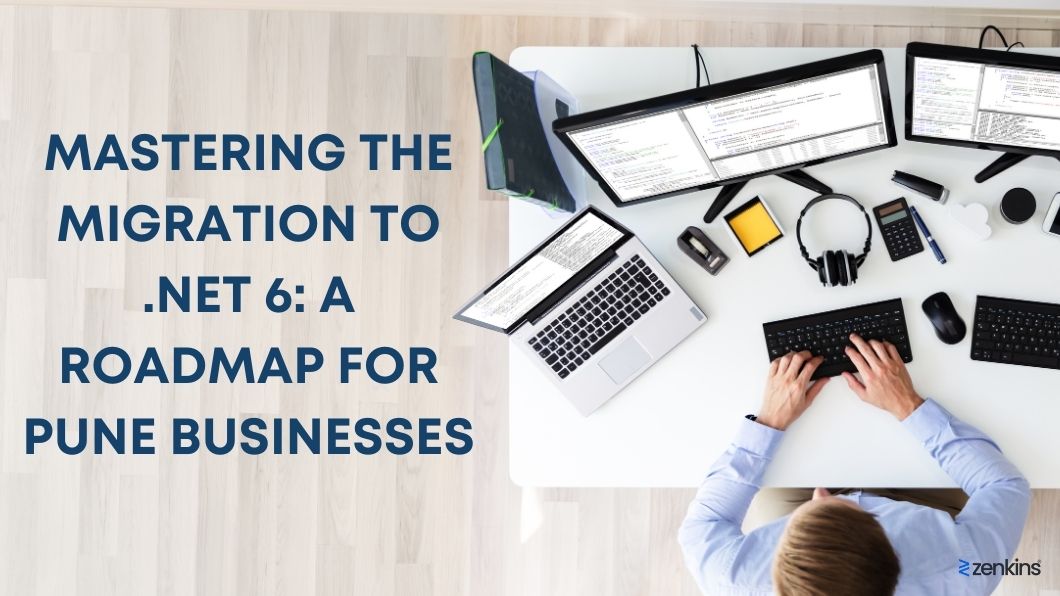Mastering the Migration to .NET 6: A Roadmap for Pune Businesses
Table of Contents
Welcome to the comprehensive guide on mastering the migration to .NET 6 for Pune businesses. As technology continues to evolve rapidly, it is crucial for organizations to stay ahead of the curve and ensure their applications are built on the latest frameworks. With the release of .NET 6, businesses in Pune have an opportunity to leverage its powerful features and benefits to enhance their software applications.
In this article, we will explore the roadmap for a successful migration to .NET 6, addressing key considerations, planning strategies, execution steps, and post-migration maintenance. Whether you are a small startup or an established enterprise, this guide will provide you with valuable insights and best practices to navigate the migration process seamlessly and unlock the full potential of .NET 6.
Introduction to .NET 6 and its Benefits for Pune Businesses
Understanding the Evolution of .NET Framework
Ah, .NET – the beloved framework that has been powering countless applications for years. But just like a fine wine, it has been evolving and getting better with age. Enter .NET 6, the latest iteration that promises even more exciting features and benefits for businesses in Pune.
Overview of the Key Features and Advantages of .NET 6
So, what’s so great about .NET 6? Well, hold onto your hats because there’s quite a lot. From improved performance to enhanced scalability, this new version has it all. It brings a host of new features, like support for cloud-native applications, improved APIs, and enhanced compatibility across platforms. It’s like giving your application a shiny new makeover, but without the expensive salon bill.
Assessing the Need for Migration: Evaluating Legacy Systems and Performance Gaps
Identifying Outdated Technologies and Limitations
Let’s face it, we all have that one friend who’s still stuck in the past, clinging onto their outdated flip phone. Well, the same can happen to your systems if you’re not careful. It’s time to assess your legacy systems and identify those outdated technologies and limitations that are holding your business back. It’s like giving your systems a much-needed fashion makeover – let’s bring them into the 21st century!
Analyzing Performance Bottlenecks and Scalability Issues
Is your application running as slow as a snail on a leisurely stroll? It’s time to put on your detective hat and analyze those performance bottlenecks and scalability issues. By pinpointing the areas that need improvement, you can make your application faster and more efficient. It’s like giving your application a shot of espresso – everything will be zipping along in no time!
Evaluating the Impact of Legacy System Dependencies
We all have that one friend who relies on others for everything, like choosing what to wear or deciding where to eat. In the world of software, legacy system dependencies can be just as clingy. It’s time to evaluate how these dependencies are impacting your business and determine if it’s time to cut those ties. It’s like freeing yourself from that friend who always drags you to the same old boring places – time to spread your wings and soar!
Why Choose a Local .NET Development Company in Pune?
Planning the Migration Strategy: Key Considerations and Best Practices
Defining Clear Objectives and Goals
Ah, the good ol’ saying: “If you don’t know where you’re going, any road will get you there.” Well, it’s time to put that saying to rest and define clear objectives and goals for your migration journey. By having a roadmap in place, you can ensure that everyone is on the same page and working towards a common goal. It’s like using a GPS to navigate through the city – you’ll reach your destination without getting lost.
Assessing the Scope and Complexity of the Migration
Just like trying to assemble a piece of IKEA furniture, migration can be a complex puzzle. It’s essential to assess the scope and complexity of your migration to avoid any surprises along the way. By understanding all the moving parts, you can plan accordingly and ensure a smooth transition. It’s like reading the instruction manual before attempting to build that bookshelf – no missing screws or confusing steps here!
Establishing a Realistic Timeline and Budget
Time and money, the two things we never seem to have enough of. When it comes to migration, it’s crucial to establish a realistic timeline and budget. By setting clear expectations, you can avoid any unnecessary stress and ensure a successful migration. It’s like sticking to a budget while shopping – you get what you need without breaking the bank.
Preparing for the Migration: Infrastructure, Resources, and Team Collaboration
Evaluating Hardware and Software Requirements
Before embarking on your migration journey, it’s time to evaluate your hardware and software requirements. Just like preparing for a trip, you need to make sure you have the right gear and tools. By assessing your needs, you can set up a solid foundation for a smooth migration. It’s like packing all the essentials for a vacation – sunscreen, check. Passport, check. It’s showtime!
Identifying and Allocating Resources
Who’s going to do all the heavy lifting during the migration? It’s time to identify and allocate the right resources. Whether it’s your in-house team or external experts, make sure you have the right people with the right skills to handle the task. It’s like assembling a superhero squad – each member brings their unique powers to save the day!
Promoting Effective Collaboration between Teams
Teamwork makes the dream work, right? Well, the same goes for migration. It’s essential to promote effective collaboration between teams to ensure a seamless process. By fostering open communication and encouraging collaboration, you can tackle any challenges that come your way. It’s like organizing a flash mob – everyone dances in sync to create something amazing!
Executing the Migration: Step-by-Step Process and Potential Challenges
Conducting a Thorough Codebase Analysis
Before diving headfirst into the migration process, it’s crucial to conduct a comprehensive codebase analysis. This analysis will help you identify any areas that may require modifications or updates to ensure a smooth transition to .NET 6. Take the time to review your codebase, identify potential pitfalls or outdated practices, and determine the best approach for migration.
Planning and Implementing an Incremental Migration Approach
Instead of attempting a massive migration all at once, it’s wise to break the process down into smaller, manageable chunks. Planning an incremental migration approach allows you to tackle one section of your application at a time, reducing the risk of overwhelming your development team and causing disruptions to your business operations. This way, you can carefully monitor the progress, address any issues that arise, and ensure a successful migration.
Addressing Common Challenges and Troubleshooting Issues
Migrating to a new framework always poses its fair share of challenges. Be prepared to encounter potential issues during the process and have a plan in place to address them effectively. Common challenges may include compatibility issues with third-party libraries, performance bottlenecks, or codebase conflicts. Keeping an open line of communication with your development team and staying up to date with relevant resources and forums can help you troubleshoot any issues that arise and ensure a smooth migration.
Testing, Debugging, and Performance Optimization in the .NET 6 Environment
Implementing Comprehensive Testing Strategies
Thorough testing is an essential step in the migration process. Implement a comprehensive testing strategy to ensure the functionality and stability of your application in the .NET 6 environment. This may include unit testing, integration testing, performance testing, and user acceptance testing. By conducting rigorous testing, you can identify and address any potential issues or regressions before your application goes live.
Debugging Techniques and Tools for .NET 6 Applications
When migrating to a new framework, you may encounter bugs or unexpected behavior in your application. Familiarize yourself with the debugging techniques and tools available in the .NET 6 environment to efficiently diagnose and resolve any issues. Visual Studio and other debugging tools offer powerful features that can help you navigate through your codebase, set breakpoints, and inspect variables to pinpoint the root cause of any problems.
Optimizing Performance for Enhanced Efficiency
Migrating to .NET 6 presents an opportunity to optimize the performance of your application. Take advantage of the new features and enhancements in the framework to improve the efficiency of your code. This may include adopting new performance optimization techniques, leveraging parallel processing capabilities, or optimizing database queries. Fine-tuning your application’s performance can lead to faster response times, improved user experience, and overall better efficiency.
Ensuring Seamless Integration and Compatibility with Existing Systems
Integrating with Existing Databases and Third-Party Systems
When migrating to .NET 6, it’s crucial to ensure seamless integration with your existing databases and third-party systems. Take the time to review your data models, APIs, and integration points to identify any areas that require adjustments or updates. Consider compatibility issues that may arise due to changes in the framework and work closely with your database administrators and third-party vendors to ensure a smooth transition.
Addressing Compatibility Issues and Legacy Data Migration
Migrating from an older version of .NET to .NET 6 may introduce compatibility issues with legacy code and data. Identify any compatibility challenges early on and plan for data migration, if required. Establish a clear strategy for handling legacy data and ensure its compatibility with the new framework. This may involve updating data schemas, transforming data, or developing migration scripts to ensure a smooth transition.
Maintaining Interoperability with Previous .NET Versions
In some cases, your migration to .NET 6 may not be a complete overhaul of your entire application. There may be components or modules that still need to interact with previous versions of .NET. Ensure that your new .NET 6 application maintains interoperability with these components to avoid disruptions and maintain a seamless user experience across different versions of your software.
Celebrating Success: Post-Migration Strategies and Continuous Improvement
Monitoring and Measuring Performance Post-Migration
Once your migration to .NET 6 is complete, it’s essential to monitor and measure the performance of your application in the new environment. Set up monitoring tools and establish performance benchmarks to ensure that the migration has improved the efficiency and stability of your application. Continuously monitor and analyze the application’s performance to identify any potential bottlenecks or areas for further optimization.
Implementing Continuous Improvement Processes
Successful migration to .NET 6 doesn’t mean the end of improvement. Implement continuous improvement processes to ensure that your application remains up to date with the latest practices and technologies. Encourage feedback from users and your development team, and regularly review your codebase to identify areas for optimization or refactoring. By embracing a culture of continuous improvement, you can ensure that your application stays efficient, reliable, and competitive in the long run.
Embracing the Latest Features and Updates in .NET 6
.NET 6 is constantly evolving, with new features and updates being released regularly. Stay informed about the latest advancements in the framework and evaluate how they can benefit your application. Embrace these new features and updates to enhance the functionality, performance, and security of your application. Keeping up with the latest trends and features can help you stay ahead of the curve and provide a better experience for your users.
Conclusion
In conclusion, migrating to .NET 6 can be a game-changer for Pune businesses, empowering them with enhanced performance, scalability, and security. By following the roadmap outlined in this article, organizations can successfully navigate the migration process and unlock the full potential of .NET 6. It is important to approach the migration with proper planning, collaboration, and testing to ensure a smooth transition and seamless integration with existing systems. With the right strategy and execution, businesses in Pune can harness the power of .NET 6 to stay competitive, deliver innovative solutions, and drive growth in the ever-evolving digital landscape.
And there you have it, a roadmap to mastering the migration to .NET 6 for Pune businesses. So, buckle up, get ready for the adventure, and let’s make your applications shine brighter than the city lights of Pune!
Frequently Asked Questions (FAQ)
Is it necessary for my business in Pune to migrate to .NET 6?
While it is not mandatory, migrating to .NET 6 can offer several significant benefits for your business. These include improved performance, enhanced security features, better scalability, and access to the latest tools and frameworks. Assessing your current technology stack, evaluating performance gaps, and considering long-term business goals can help determine if migrating to .NET 6 is the right choice for your organization.
What are the potential challenges involved in migrating to .NET 6?
Migrating to .NET 6 may present some challenges, such as compatibility issues with legacy systems, potential disruption to ongoing projects, and the need for additional training or upskilling of developers. It is important to plan and execute the migration carefully, conduct thorough testing, and address any compatibility or performance issues that may arise during the process. Working closely with experienced developers and following best practices can help mitigate these challenges.
How long does the migration process to .NET 6 typically take?
The duration of the migration process can vary depending on factors such as the complexity of your applications, the size of the codebase, and the availability of resources. A well-planned migration can be executed incrementally, allowing you to migrate specific modules or components one at a time, reducing the overall impact on your business operations. It is crucial to establish a realistic timeline based on your specific requirements and allocate sufficient resources to ensure a smooth and efficient migration.




